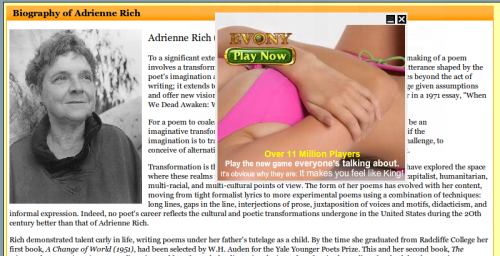Photographs have played a major role in framing the environmental movement, and groups have used images to draw public attention and concern to specific issues. A famous example is the “Earthrise” image taken in 1968 from Apollo 8, the first time an image of this sort was taken by an actual person, rather than a satellite. The seeming fragility of the planet, clearly shown as an interconnected and isolated entity, has been largely credited with increasing concerns about and awareness of environmental issues:

Life magazine included it in a list of “100 photographs that changed the world.”
On June 22, 1969, the Cuyahoga River in Ohio caught on fire. News spread, and the story — the shock many Americans experienced when they heard that rivers were catching on fire — increased concerns about water pollution, eventually leading to the 1972 Clean Water Act. Dramatic photos of the Cuyahoga burning appeared.
There was one small detail with the images that often went unnoticed: as far as anyone can tell, no one took any photos of the river burning in 1969. If you look online now, you’ll find lots of images from a fire in 1952, but none from 1969. At the time, rivers catching on fire in the former industrial centers around the Great Lakes weren’t really shocking; it happened pretty frequently and had been for decades. The 1969 fire was, if anything, unexceptional. It only lasted half an hour and didn’t do much damage.
Of course, context and timing are everything. The story about the 1969 fire emerged at a time when concerns about environmental pollution and safety were increasing, so an event that might have been completely ignored outside the local area, as they had been in the past, instead became a flashpoint in the environmental movement, and images of rivers on fire now seem shocking to us. I think most Americans would see a river catching on fire as inherently problematic, an automatic sign of a major environmental problem, rather than an unavoidable and unremarkable outcome of economic progress.
Given the force of images in these instances (and others), I can’t help but wonder what the effects will be of photos of the current oil spill in the Gulf of Mexico, particularly as it approaches the coasts. Dmitriy T.M. sent in a set of images. The oil spill, and the images we’ll continue to get of it, come soon after President Obama announced his support for offshore drilling in a number of areas, including the Atlantic coast and the Gulf of Mexico. The plan, already controversial, is likely to meet even more resistance now, particularly from residents in communities that are not dependent on oil drilling for their livelihoods and fear the effects of an oil spill. Public concern is likely to increase even further when the oil hits coastal areas and we begin to see images of oil-covered wildlife, beaches, and so on, much as we did after the Exxon Valdez spill.
These images are already striking, but the power of an image is highly connected to the social/historical context in which is arises (much as photos of rivers on fire didn’t cause a huge national stir until they became emblematic of the need for environmental regulations). I can’t help but think that the last photo I posted above will have more resonance than it might have otherwise because of the way it will intersect with memories of Hurricane Katrina bearing down on New Orleans — I suspect that a story that would be attention-getting regardless will be even more so now that it will connect to ideas of New Orleans as a beleaguered city, endangered by a string of natural and human-caused disasters.
——————————-
See also our post on how photographs of the fetus changed how we think about pregnancy and abortion and, for an interesting controversy regarding photography, see our post on Shelby Lee Adam’s images of Appalacians.
Gwen Sharp is an associate professor of sociology at Nevada State College. You can follow her on Twitter at @gwensharpnv.



